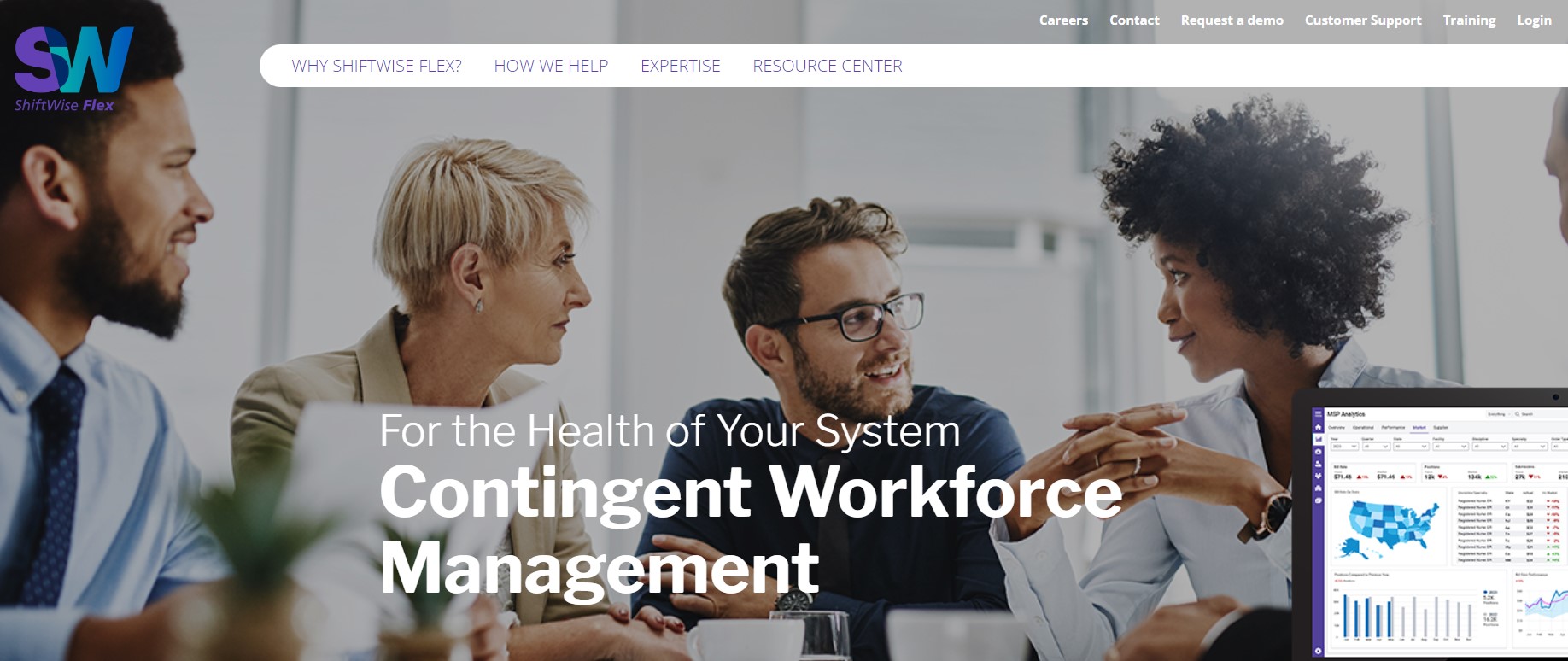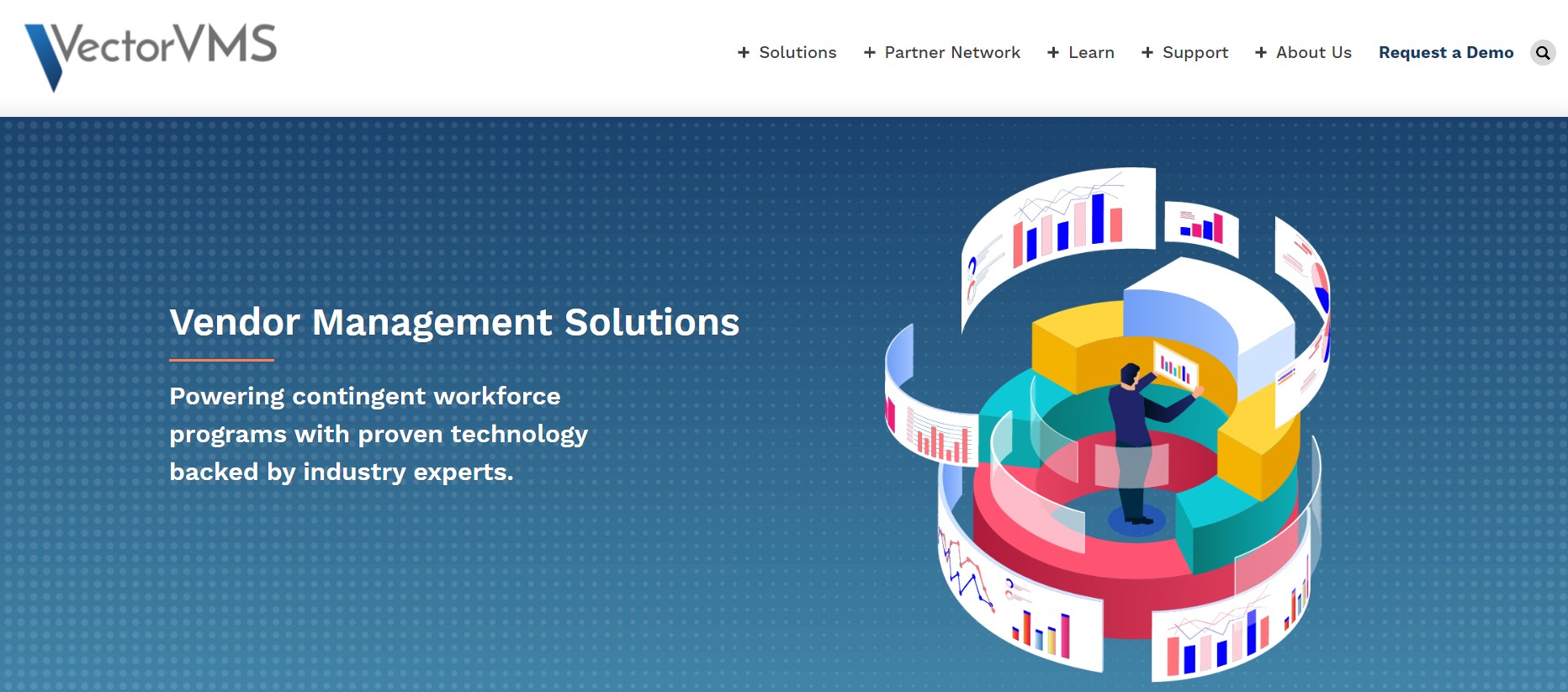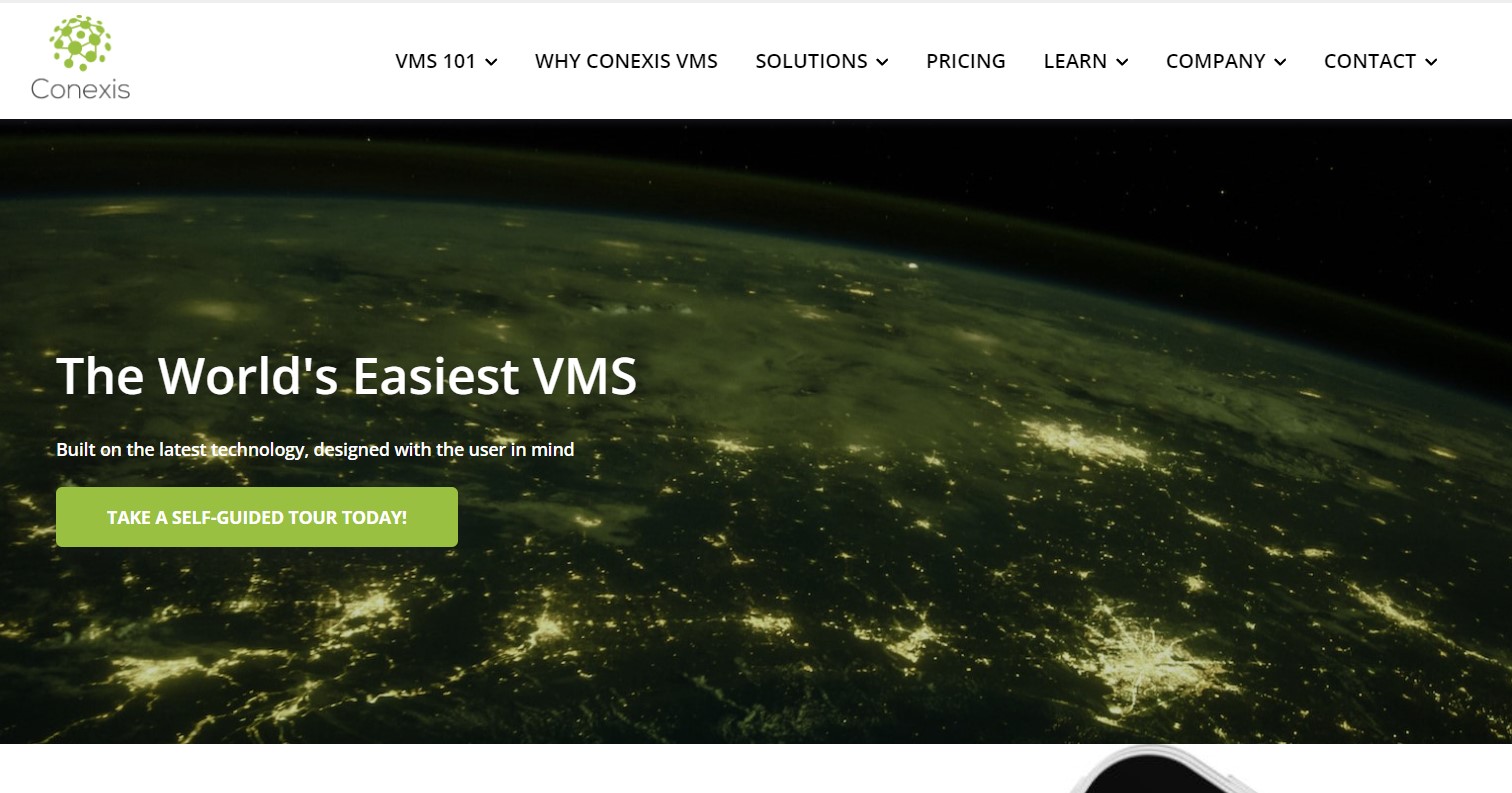Contingent workers are valuable for building your workforce. They’re a quick, affordable way to fill skill gaps and facilitate growth.
However, it’s notoriously difficult to source and hire high-quality contractors. One Canadian survey found that 50% of respondents had issues hiring a contractor, and 64% said they didn’t trust them.[1]
Even after hiring the right one, collaboration can be strained by having no solid way to communicate with them.
A vendor management system enables you to reap all the benefits of contractors while leaving the tricky parts behind. This HR technology helps you sort through hundreds of possible contingent workers and source the best ones.
After hiring, it further improves your experience by streamlining communication between teams and helping you manage tricky issues like compliance and classification.
This article discusses the benefits and top strategies for using a contractor management system. We also list our top software recommendations to get you started.
Table of contents
- What is a vendor management system?
- Why is a VMS (vendor management system) important to HR professionals?
- The benefits of vendor management system (VMS)
- 5 best VMS software
- 5 best practices for leveraging VMS systems in your HR department
- 3 examples of companies succeeding with VMS software
- Watch your contingent workforce shine with a vendor management system
- Vendor management system FAQs
What is a vendor management system?
A vendor management system (VMS) is software that helps you manage the lifecycle of your contingent workers, including sourcing, engaging, communicating, invoicing, and offboarding.
These tools help HR professionals manage costs, risks, and compliance on one platform.
It’s important to note that “vendor management system” can also refer to tools that manage the supply chain, purchase orders, supplier relationship management, and procurement, so it’s crucial to understand which tool you’re looking for.
The VMS software we’re discussing here helps HR professionals manage contingent workers, such as:
Freelancers
Contractors or contract workers
Self-employed consultants
Temporary workers
Outsourced workers
If your company regularly relies on these workers, a vendor management system is a must-have for your HR tech stack.
When combined with other tools, like candidate assessment software, it makes filling skill gaps and scaling your business simple and effective.
Why is a VMS (vendor management system) important to HR professionals?
Project-based hiring is accelerating at a rapid pace.
More professionals are offering their contingent services, and more organizations are realizing the benefits of harnessing these affordable, adaptable workers.
This massive market is worth tapping into – contingent workers comprise between 30% and 50% of the workforce.
However, you need the right strategy to take advantage of these resources, and experts recommend using software to integrate them into your company.
A VMS is one of the top HR technology trends.
Frequently, companies use these tools with remote work technology, another rising trend, because many contingent workers are flexible and distributed.
A contract management system helps you manage, source, and select contingent and project-based hires to build better strategies to set up your workforce in cost-effective, efficient ways.
These vendor management software tools also help increase collaboration between employees and contractors and across projects and departments, improving overall efficiency and productivity.
For example, you can streamline your processes by integrating your VMS software with recruiting platforms so you can seamlessly flow from selecting a contractor to hiring them.
The benefits of vendor management system (VMS)
The best VMS software empowers HR teams to hire the right contractors efficiently, conduct risk management, and streamline the vendor management process.
These tools manage compliance, reduce costs, and boost productivity.
1. Manage workforce compliance and mitigate risks
There are many complex rules surrounding the hiring and managing of contractors, including the onboarding process, approval workflows, and vendor relationship management.
An important rule of compliance management is proper classification. Misclassifying a contingent worker as an employee can have detrimental effects. For example, a construction services company paid over $1.6m in damages due to misclassification.[2]
Vendor management system tools help you manage compliance and follow regulations, mitigating the risks associated with project-based workers so you can reap the benefits with none of the issues.
Mitigating risks is especially helpful when hiring international contractors because juggling compliance and laws between two or more countries can be tricky.
Using a contractor management system in combination with compensation management software also helps you pay each contingent worker what you owe them in compliance with their country’s laws.
2. Reduce costs
Vendor management system software helps you sort through and choose the best contractors, enabling you to get the ideal price and quality. These tools also help you decide whether to hire a contractor or a new full-time employee.
Measuring costs and making strategic decisions is difficult when you don’t have a database for easy comparison.
For example, a glass and ceramics company adopted a cloud-based vendor management system and used it to build a personalized strategy. It focused on its specific challenges: better labor sourcing, increased workforce visibility, and risk mitigation.
Its VMS software helped it achieve $25.7m in cost savings in five years, filling 130 open positions.
3. Increase productivity by automating tedious, manual tasks
Your HR team spends much time on small, repetitive tasks. More than 50% of managers spend eight hours per week on manual tasks, and 25% spend over 20 or more hours.[3]
That’s an average of four hours per workday spent on tedious, manual responsibilities.
HR automation is essential in a modern landscape, especially when managing contractors. A lot of effort needs to go into classification and compliance.
Automating these repetitive business processes saves time and reduces human error.
There are also several small duties that are better automated, such as sourcing, approvals, hiring, and training.
4. Supports scaling and growth
Human resources teams face a lot of pressure during organizational growth. Many companies scale with little addition to HR departments, so they manage more staff with the same number of HR employees. A vendor management solution gives you much-needed support.
Further, if a company grows rapidly, it has increasingly wide skill gaps.
Contingent workers are a great way to address these gaps and assist scaling. You may only need a contingent engineer for six months until you flesh out the role and find a full-time employee, so a contractor is the perfect temporary solution.
Vendor management systems support this need so you can scale comfortably and focus your attention on your company.
It’s also worth noting that contractor management systems reduce costs. Managing costs is one of the top concerns when scaling organizations.
5 best VMS software
A contingent workforce is a valuable resource, and whether you’re just getting started or managing an ongoing one, let’s make sure you get the most out of it.
Here’s our list of the five top VMS systems available, including pricing, notable features, and pros and cons.
Factors we considered
Here’s a quick overview of what matters when choosing the best vendor management software:
Data, analytics, and reporting: VMS systems with HR analytics software features enable you to collect and report on crucial contractor data
Built-in compliance tools: These tools help you manage contingent worker regulations and laws, as well as handle global laws and tax structures
Billing and invoicing: It’s important to have billing and invoicing features in your VMS because contractors are external workers whom you don’t manage through your payroll software
Integrations and management tools: You need to integrate your VMS with other helpful tools, such as applicant tracking systems and job boards
The best vendor management system tools: A summary
Software | Top features |
1. SAP Fieldglass | - Streamlined procurement - Simple assignment management - Intuitive project management dashboard |
2. Magnit | - Simple interface and easy-to-navigate - Branded UI and deep customization modules - AI candidate sourcing |
3. Shiftwise | - Designed for healthcare professionals - Connected to more than 1,100 staffing solutions - Provides a suite of client services |
4. VectorVMS | - Provides three different software models - Consolidated billing - Smooth integration with many applicant tracking systems |
5. Conexis | - Excellent for small businesses - Streamlined procurement and payment automation - Simple candidate tracking |
1. SAP Fieldglass: Best overall
SAP Fieldglass is a well-known name in the vendor management system market, and for good reason.
This software solution assists the entire contingent lifecycle, starting with streamlined procurement, going into assignment management, and ending with excellent offboarding software features.
It has an intuitive project management dashboard where you can find and engage all of your contractors. It also has smooth, organized invoicing.
SAP Fieldglass also includes employee self-service features that contingent workers love, such as comprehensive timekeeping.
Pros | Cons |
- Organized timekeeping and invoicing - Compliance monitoring - Custom reporting - Assignment management | - Steep learning curve - High implementation costs |
Rating: 4.5 out of five (G2)
Pricing at time of writing: Available upon request
2. Magnit: Best user experience
Magnit delivers an excellent user experience alongside a solid worker experience.
This software goes beyond a straightforward interface and has features that enhance your experience, such as a branded UI, an easy-to-navigate system, deep customization for clients and workers, and personalized, task-based roles and permissions.
Magnit also uses machine learning in HR capabilities to help you source better contingent candidates.
Pros | Cons |
- More than 1,800 integrations - AI predictive analytics and candidate sourcing - Detailed data and insights - Integrated employee of record (EoR) services | - Minor bugs and glitches - No way to save the most common hours worked to improve timekeeping |
Rating: 4.5 out of five (G2)
Pricing at time of writing: Available upon request
3. Shiftwise: Best for healthcare
Shiftwise is a platform designed especially for the healthcare sector, meaning that it can handle extremely delicate compliance and regulatory specifications.
This software is connected to more than 1,100 healthcare staffing solutions and fills clinical roles and laboratory, therapy, radiology, and nursing positions.
It also hosts a full suite of client services to help support you, such as account management, customer support, and implementation.
Pros | Cons |
- Automated ordering, invoicing, reporting of KPIs and metrics - Built for the healthcare sector - End-to-end client services - Simple interface | - A slightly steep learning curve - Not the most attractive interface |
Rating: 4.0 out of five (G2)
Pricing at time of writing: Available upon request
4. VectorVMS: Best with multiple models
VectorVMS is a contactor management system that enables users to choose from several models to align their software with what works best for their organization.
These models include:
Technology license: Just the software so teams can procure and manage talent
Shared managed services: The software, plus strategic and admin support
Managed service provider: The software, plus total management by a provider
VectorVMS also has streamlined integration with several applicant tracking systems to simplify and optimize your recruitment efforts.
Pros | Cons |
- Intuitive dashboard - Large network of vendors - Easy integration with applicant tracking systems - Consolidated billing | - Inconsistent customer support - Interface is not straightforward for all users |
Rating: 4.5 out of five (G2)
Pricing at time of writing: Available upon request
5. Conexis: Best for small HR teams
Conexis is one of the top vendor management systems for small HR teams.
Small businesses love how this software helps them manage their contingent workforce, with one review saying:
“Conexis demonstrated that they are specialists in smaller spending levels. They did the implementation for no cost, and we were up and running in two weeks.”
This tool also automates essential functions, such as procurement and payment of contingent workers and communication with the vendors that provide them.
Pros | Cons |
- Straightforward interface - Real-time vendor information - Customized permissions via personalized profiles - Easy candidate tracking and submission - Automation of accounts payable | - No multilingual support - Not suited for larger companies’ spend management |
Rating: Five out of five (Capterra)
Pricing at time of writing: Available upon request
5 best practices for leveraging VMS systems in your HR department
Browse our recommendations and start shortlisting your options – but as you decide, check out our top strategies for using your VMS software.
Strategies for using vendor management systems: A summary
Strategy | What it accomplishes |
1. Source contingent workers with a VMS and gauge their quality with talent assessments | Verifies contingent worker skills so you can confidently hire the best |
2. Ensure global workforce compliance | Manages tricky international regulations and payments so you can extend your reach |
3. Integrate your systems to create complete workforce visibility | Connects your systems to give you visibility of your external and internal workforce |
4. Centralize, analyze, and leverage all workforce data | Analyze your workforce data and use it to make strategic decisions |
5. Harness AI and automation in your VMS | Automates simple processes so you can focus on more important things |
1. Source contingent workers with a VMS and gauge their quality with talent assessments
You can get more value from vendor management system software when you combine it with other great tech. We recommend using it alongside talent assessment software.
Contingent workers are a quick, affordable way to fill skill gaps, but there are some drawbacks, like finding unreliable contractors who don’t have the right skills.
You can eliminate this drawback by accurately and objectively gauging their skills with talent assessments.
Here’s an example process:
Use VMS software to source professionals
Send these workers talent assessments to verify their skills
Invite the best talent to interviews
Hire your chosen contractors
Manage, pay, and communicate with workers through your VMS
The skills and quality of contingent workers can be tough to verify, but using skills tests enables you to recruit them with confidence.
For more information, read our article on using skills-based hiring to recruit contingent workers effectively.
2. Ensure global workforce compliance
Countless freelancers and contractors operate overseas, enabling organizations to widen their talent pools, find new skills, and secure professionals within their price range.
However, it’s critical to be careful when managing these international workers.
Compliance is a tricky issue, and one mistake could be extremely damaging, but it gets even more difficult when dealing with laws from multiple countries.
The best vendor management systems help you manage local and global compliance.
Harness your VMS software’s capabilities to:
Manage global compliance
Handle invoicing requirements
Support local currency billing
Navigate employment laws
Handle data regulations
Extending your reach to different countries is a smart move, and it would be a shame if confusing compliance held you back. Using a VMS, you can empower your business decisions and hire great international contractors.
3. Integrate your systems to create complete workforce visibility
Many organizations have a blended workforce, meaning your company’s entire workforce includes many professionals, including full-time employees, marketplace sellers, contractors, and even AI bots.
They need a customizable, user-friendly vendor management platform with vendor data and management tools.
You need a centralized location to oversee and manage your entire workforce, no matter which type of worker they are. This way, you have crucial visibility and can monitor compensation, development, and productivity.
Connect your VMS and human capital management (HCM) solution to create complete workforce visibility, eliminate siloed data sources, and help your HR team better plan their employee makeup.
This strategy helps you seamlessly integrate your data and get a holistic view of every valuable member of your company.
However, it’s important to remember that not every vendor management system integrates smoothly with HCMs, so this should be a top consideration as you browse around and make your final decision.
4. Centralize, analyze, and leverage all workforce data
After you’ve connected your platforms and created a single source for your workforce, it’s time to put your data to work.
Integration isn’t just about convenience. Having all your data in one place enables you to analyze employee and contractor data and make better decisions across your workforce.
Here are a few integrated vendor management system examples for getting the most out of your data:
Use your VMS contractor database with your talent assessment candidate results to spot top performers and rehire them
Use your VMS to discover which contractors are too expensive compared to performance, and then reduce spending on them in favor of more affordable but skilled workers
Agile strategies enable you to continuously improve vendor performance, reducing costs and increasing efficiency.
To simplify this process, link this data to a detailed HR dashboard.
5. Harness AI and automation in your VMS
Take advantage of automation and AI in HR to make handling contractors easier and more efficient. Using automation reduces human error and ensures small details, like regular follow-ups with contractors and their vendors, don’t slip through the cracks.
AI can deal with the following functions and send you notifications:
Screening based on contractor rates
Predictive analysis
Global compliance checklists
Sending vendor onboarding information
Small, tedious tasks to increase productivity, such as quick messages
When these tools handle small, manual tasks, they improve productivity, reduce errors, and give you more time to build relationships and make strategic decisions.
For more information on this topic, check out our blog post on recruitment automation software.
3 examples of companies succeeding with VMS software
The best VMS software can transform your contingent worker experience, reducing costs and streamlining management.
But let’s do more than talk about it – here are three real-life vendor management system examples to inspire your next strategy:
Toyota
Australian Taxation Office
CenterWell Home Health
1. Toyota
Toyota, the well-known automotive brand, relies heavily on contingent labor to achieve its business goals. However, it discovered a large roadblock in its contingent workforce strategy – a lack of total visibility.
It also realized it had no consistency and standardization between repositories and no risk and compliance monitoring system, which resulted in inconsistent contracts and rates.
Toyota found a reliable vendor management system that solved its primary issues and provided the needed automation and detailed data capture. It enhanced the company’s hiring strategy, reducing time-to-hire and increasing access to high-quality talent.
Here are the quantifiable results:
$620,000 in direct sourcing cost savings
35% conversion rate of positions
13% increase in diversity spend
Decreased time-to-fill by 18 days [4]
2. Australian Taxation Office
The workforce of the Australian Taxation Office (ATO) is complex, to say the least. Its HR professionals must handle employees, temporary staff, external workers, and service providers.
It must also meet strict compliance requirements for how it manages its people because it’s a federal government agency.
This organization adopted VMS software to create templates to manage its compliance needs safely and effectively. In addition to handling compliance, the ATO wanted to enhance visibility into its external workforce and costs and create a more seamless workflow.
ATO saw immediate, impressive results:
Data transparency that improved strategic decisions
Increased worker engagement, retention, and performance
Improved accountability throughout the procurement process
Ongoing cost reductions
The Australian Taxation Office sees cost savings of about AUD 210K per month after implementing a VMS system and its new contract arrangements.[5]
3. CenterWell Home Health
CenterWell Home Health, a home health services provider, relies on a large contingent workforce to provide care for its clients.
This company identified problems with its contingent strategy, like driving cost savings while maintaining high-quality contingent work and patient care. It also needed standardized practices and better collaboration and communication.
CenterWell Home Health found a contractor management system, enabling it to strategically manage its external workforce and strengthen its compliance.
Here are some of the highlights of the results:
More than 420 contracts filled in one year, 70% of them registered nurse positions
28% reduction in time-to-fill
50% increase in diversity spend
It also harnessed data from its performance management systems to optimize vendor choices, sourcing contractors from the best suppliers.[6]
Watch your contingent workforce shine with a vendor management system
Taking advantage of a contingent workforce is a winning strategy for your organization, and you can fully reap the benefits with a vendor management system.
A sophisticated, automated system deals better with risky issues like compliance and regulations. The same goes for tedious tasks like invoicing and communication.
When you streamline these processes, your team can focus on hiring skilled professionals and maintaining strong relationships with them.
For more insights on how to verify these skills, read our guide on candidate assessment software.
Looking to get started right away?
Watch a live demo of TestGorilla talent assessments, or sign up for a free account today!
Vendor management system FAQs
To finish up, let’s review a few frequently asked questions about vendor management systems.
What is contingent workforce management?
Contingent workforce management is the procurement and engagement of non-permanent workers, such as contractors and freelancers.
Vendor management systems are a key component in this management, helping you hire better project-based workers and manage them effectively.
What is a vendor management system in staffing?
A vendor management system’s staffing consists of sourcing, tracking, and recruitment functions.
However, functionality goes much further, helping you communicate with contingent workers, manage their invoices, and monitor their data.
What is an example of a vendor management system?
The most well-known vendor management system is SAP Fieldglass, but many more are available on the market.
Other popular vendor management system examples include Procurify and Gatekeeper. However, these well-known tools are for managing suppliers instead of contractors.
Who needs a vendor management system?
Most companies that handle many non-permanent workers, such as healthcare companies, should invest in a high-quality vendor management system as part of their ERP system.
We recommend assessing your contingent workforce processes and running a risk assessment to check for bottlenecks, recurring issues, and inefficiencies to determine your organization’s needs.
Sources
1. Olson, Jeri. (April 11, 2022). "Finding a Contractor Proves Difficult Task for Canadians". Service Line Warranties. Retrieved January 25, 2024. https://servicelinewarranties.ca/finding-a-contractor-proves-difficult-task-for-canadians/
2. "IC misclassification: Construction services contractor pays more than $1.6 million". (August 16, 2023). Contingent Workforce Strategies. Retrieved January 25, 2024. https://cwstrategies.staffingindustry.com/ic-misclassification-construction-services-contractor-pays-more-than-1-6-million/
3. “Top Findings from Our State of Workflow Automation Survey”. (September 4, 2018). Formstack. Retrieved January 28, 2024. https://www.formstack.com/blog/workflow-automation-survey
4. "Toyota Achieves Unparalleled Workforce Visibility with Magnit". (June 22, 2023). Magnit. Retrieved January 25, 2024. https://magnitglobal.com/us/en/resources/knowledge-center/case-study/toyota-achieves-unparalleled-workforce-visibility-with-magnit.html
5. “The Australian Taxation Office Achieves Improved Visibility into Its External IT LAbor Hire Engagements”. (2016). SAPFieldglass. Retrieved January 28, 2024.https://cdn.featuredcustomers.com/CustomerCaseStudy.document/sap-fieldglass_australian-taxation-office_49484.pdf
6. "CenterWell Home Health Transforms Contingent Workforce with RightSourcing". (June 1, 2023). Magnit. Retrieved January 25, 2024. https://magnitglobal.com/us/en/resources/knowledge-center/case-study/centerwell-home-health-transforms-contingent-workforce-with-rightsourcing.html
Related posts
Hire the best candidates with TestGorilla
Create pre-employment assessments in minutes to screen candidates, save time, and hire the best talent.
Latest posts
The best advice in pre-employment testing, in your inbox.
No spam. Unsubscribe at any time.

Hire the best. No bias. No stress.
Our screening tests identify the best candidates and make your hiring decisions faster, easier, and bias-free.
Free resources
This checklist covers key features you should look for when choosing a skills testing platform
This resource will help you develop an onboarding checklist for new hires.
How to assess your candidates' attention to detail.
Learn how to get human resources certified through HRCI or SHRM.
Learn how you can improve the level of talent at your company.
Learn how CapitalT reduced hiring bias with online skills assessments.
Learn how to make the resume process more efficient and more effective.
Improve your hiring strategy with these 7 critical recruitment metrics.
Learn how Sukhi decreased time spent reviewing resumes by 83%!
Hire more efficiently with these hacks that 99% of recruiters aren't using.
Make a business case for diversity and inclusion initiatives with this data.






















